人教版新目标九年级英语Unit11单元集体备课教案
- 格式:doc
- 大小:125.50 KB
- 文档页数:12
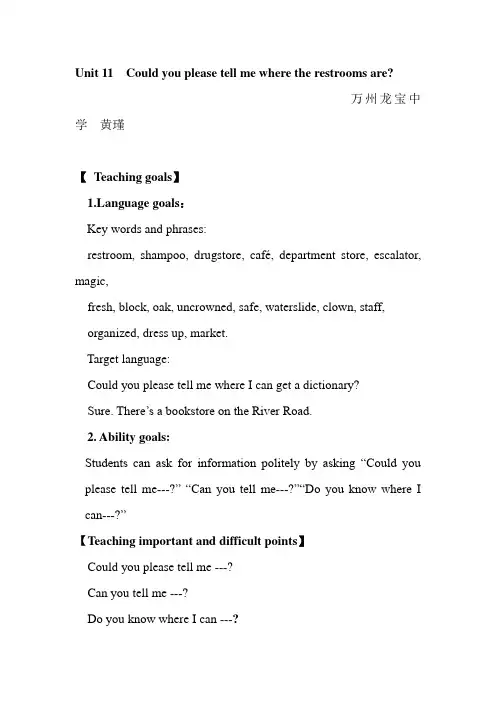
Unit 11 Could you please tell me where the restrooms are?万州龙宝中学黄瑾【Teaching goals】nguage goals:Key words and phrases:restroom, shampoo, drugstore, café, department store, escalator, magic,fresh, block, oak, uncrowned, safe, waterslide, clown, staff, organized, dress up, market.Target language:Could you please tell me where I can get a dictionary?Sure. There’s a bookstore on the River Road.2. Ability goals:Students can ask for information politely by asking “Could you please tell me---?” “Can you tell me---?”“Do you know where I can---?”【Teaching important and difficult points】Could you please tell me ---?Can you tell me ---?Do you know where I can ---?【Teaching methods】Reading, listening, making conversations, discussion in groups 【Teaching aids】A recorder【Teaching procedures】Section AThe First Period (1a—1c)Step1: Greeting and duty reportOne student give a duty report, the other students can ask some questions according to the report.Step2:Lead-inAsk students to pretend they are new to this school.T: How can you ask where the library is?Ss: Can you tell me where the library is?T: There is another polite way you can ask: Could you pleasetell me where the library is?Write down the two questions on the board, and ask Ss to practice the questions.Step3:1aRead the instructions to the class.Read the list of things in the box. Review the meaning of each item.Point to the lettered parts of the picture one by one. What place is this? What do they sell there?Ask Ss to match each thing with a place in the picture, and tell them there may be more one correct answer for some blanks.Step4: 1b ListeningAsk Ss to look at the pictures. Point out the two conversations that are shown in the picture. Say, Listen to the conversations and fill in the blanks with the words you hear in the recording.Play the recording twice. Stop the recording from time to time to allow Ss enough time to fill in the blanks.Check the answers.Step5: 1c PairworkRead the instructions and ask Ss to read the sample conversation.Say, look at the list of things people need and the pictures of the places in 1a.Have a conversation with your partner. Ask your partner politely where you can do these things.Ask a few Ss to present their conversation.Homework:Make a dialogue like 1c and write down in the exercise book.Blackboard Designbuy shampoo /some writing paper/some stampsget some magazines/a dictionary/some informationsave moneyCan you tell me where the library is?Could you please tell me where the library is?--Could you please tell me where I can buy some stamps?--Yes. There’s a post office on the Center Street.The Second Period (2a—2c)Step1: Duty report and revisionOne student gives a duty report as usual.Check the homework. Ask some Ss to read their conversation in pairs.Step2: PresentationAsk Ss to look at the picture in2a.Introduce the places in it, especially the escalator and the elevator.Step3: Listening (2a)You will hear one boy ask another boy how to find something in a shopping mall. The sentences are in the wrong order. Number the directions from 1 to 4.Play the recording twice. Ss write the numbers.Check the answers.2b Listen again. Show how the boy walks to the drugstore. Draw a line on the picture.Play the recording again and ask Ss to draw the line on their own.Check the answers.Step4: PairworkAsk two Ss to read the sample conversation. Have Ss follow the directions by looking at the picture.Say, Make a conversation using information in the picture.Ask Ss to work in pairs, then get one or two pairs to present their conversations.Step5: Grammar FocusReview the grammar box. Ask Ss to read the questions.Write three questions starters on the board:Could you please tell me how to get to ---?Can you tell me where ---?Do you know where ---?Ask Ss to complete each sentence using their own words. Homework:Practice the conversation in 2a, 2b and try to recite it and write their own conversation like this.Blackboard Design1.Take the escalator to the second floor.2.Turn left.3.Go past the bank.4.The drugstore is between ---Q1. Could you please tell me how to get to ---?Q2. Can you tell me where ---?Q3. Do you know where --- ?The Third Period (3a—4)Step1: Duty report and revisionGive a duty report.Ask some Ss to read out their conversations.Step2: Reading (2a)Writing the words advantages and disadvantages on the board, and ask Ss to give examples from their lives. For example,What are the advantages and disadvantages to own a car?Read the first two sentences at the top of the article. Explain that the interviewer will talk to some teenagers.Ss read the article. When they have finished, ask if there are any words or sentences they don’t understand. Write them and ask other Ss to explain them in their own words.Then Ss read the interview again and write the advantagesand disadvantages.Check the answers.Step3: GroupworkAsk Ss to read the sample conversation.You can talk about places where you usually hang out and the advantages and disadvantages of each place.Ask Ss to work in groups. As they work, move around the room offering help as needed.Ask a few groups to present their conversation.Step 4: DrillingRead the instructions to the class.Read the example in the box.Ask Ss to say the names of some stores and other places in the town and write them on the board.Divide the class into some groups. Each group chooses one place to write about. Write careful directions from the school to each place, but do not say the name of the place. When the groups are ready, they read their directions to the class and the other Ss guess the names of the places.HomeworkWrite a place you usually hang out and tell the reasons.Blackboard DesignAdvantages Disadvantages Friends hang out there air is not freshAlways something happening usually crowded Free contents, listen to CDs always spend too much moneyLook at books in the bookstore▲ Hang out The air is not fresh .I prefer being outside.Places: Xiangsheng Restaurant Huijia Store Longge BookstoreSection BThe First Period (1—2c)Step 1: Greeting and Duty reportSay hello to the Ss and a duty reporter is welcomed.Step 2: PresentationSs read the words in the box. If there are some words that Ss don’t understand, you can ask other Ss to explain the words.Read the instructions and point out the sample answer. Ask Ss to write words from the box in the blank on their own.Correct the answers by having Ss read the qualities he or she listed.Step 3: DrillingAsk Ss to read the sample conversation.Now work with a partner. Look at the words in the box and use them to talk about places in your own city.Ask a few pairs of Ss to present their conversations to the class.Step 4: ListeningAsk Ss to look at the picture and ask Ss to tell what is happening. Explain that the scene shows a family on vacation.They are asking the man for information about various things to do in Sun Ville.Read the instruction and say. You will hear three different conversations. Listen to the recording and write what place they ask about in each conversation.Play the recording twice. Ss write the places people ask about.Check the answers.Let Ss look at the chart in 2b.Say, listen again. This time listen carefully to the answers the clerk gives. Write the answers in the blanks.Play the recording again. Then check the answers.Step 5: PracticeLet Ss read after the tape twice. And try to role play theconversation between the man and the tourists.Ask one or two pairs to present their conversation. HomeworkWrite down the conversations they make.Blackboard DesignFascinating: having strong charm uncrowned: not crowdedSafe: not dangerous convenient: easy to get to, suitableClerk: person employed in a bank, office, shopConversation1: Green landConversation2: the corner of Market and Middle Streets Conversation3: the computer museumThe Second Period (3a-4)Step1: Greeting and reportSay hello to the Ss and one student give a duty report.Step2: lead-inSs look at the picture. Ask: Where can you guess is it? Introduce Watertown, water slides. Ask Ss to find out the Places in the picture, such as Café, Sports Museum, Science Museum and so on.Ask one student to read the passage aloud. Correct any pronunciation errors to make sure the student are providing a good model for the rest of the class.Ask Ss to complete the work individually. Then review the task. Ask a few students to tell the class about the answers in the chart.Step3: ReadingLet Ss look back at 2a and 2b.Say, Use this information to help you complete the guide to Sun Ville.Ask Ss to complete the Writing .As they work, move around the room offering help and answering questions as needed.Ask a student to read the completed article to the class.Step4: 3c PracticeAsk Ss to say the names of some of the places they might write about. Write a list of the places on the board.Ss work individually. Tell them that they can use what they wrote for 3b as a guide.Step5: PerformanceRead the instruction to the class. Ask Ss to look back the guides they wrote in 3c.Have different Ss take the role of the booth worker and the different tourists. Be sure every student has a chance to participate.Ask one or two groups to present their conversations, Homework:Practice the article in 3a and try to retell it.Blackboard DesignWatertown water slidesKids Teenagers ParentsEat Clown City CaféUncle Bob’s Farmer’s MarketHave fun organized games water slides dance lessonsClowns rock bandLearn Science Museum Sports Museum History Museum。
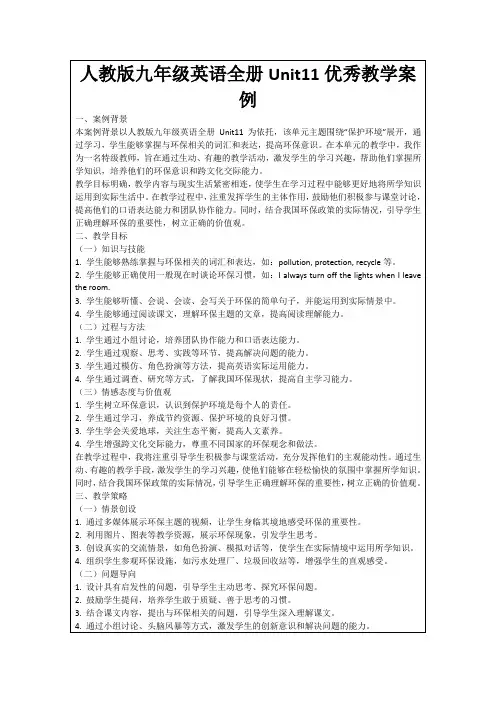
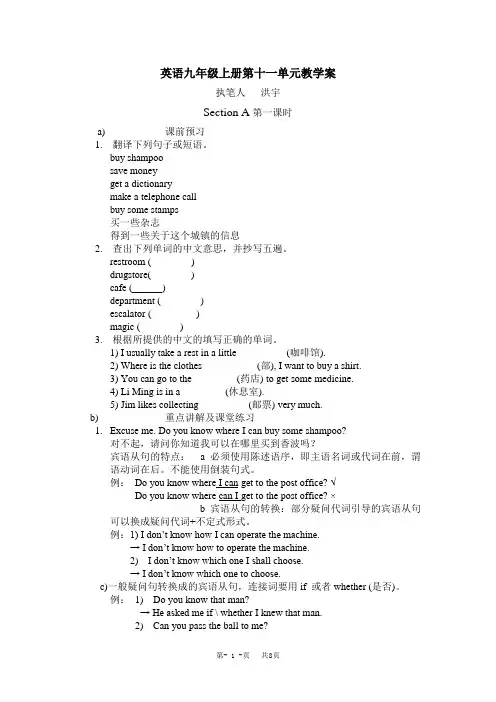
英语九年级上册第十一单元教学案执笔人洪宇Section A第一课时a)课前预习1. 翻译下列句子或短语。
buy shampoo ______________________save money ______________________get a dictionary ______________________make a telephone call ______________________buy some stamps ______________________买一些杂志______________________得到一些关于这个城镇的信息____________________________2. 查出下列单词的中文意思,并抄写五遍。
restroom (________)____________________________________________ drugstore(________) __________________________________________ cafe ( ) _________________________________________________ department (________)_________________________________________ escalator (_________) __________________________________________ magic (________) ______________________________________________ 3. 根据所提供的中文的填写正确的单词。
1) I usually take a rest in a little _________ (咖啡馆).2) Where is the clothes __________ (部), I want to buy a shirt.3) You can go to the ________ (药店) to get some medicine.4) Li Ming is in a ________ (休息室).5) Jim likes collecting _________ (邮票) very much.b)重点讲解及课堂练习1.Excuse me. Do you know where I can buy some shampoo?对不起,请问你知道我可以在哪里买到香波吗?宾语从句的特点: a 必须使用陈述语序,即主语名词或代词在前,谓语动词在后。

人教版九年级英语unit11单元整体教学设计The teaching of Unit 11 in the 9th grade English textbook published by the People's Education Press is a crucial part of the English curriculum. This unit covers a wide range of topics and language skills that are essential for students' overall language development. In this essay, I will provide a comprehensive teaching design for this unit, outlining the learning objectives, teaching strategies, and assessment methods.Learning Objectives:The primary learning objectives for Unit 11 are to enhance students' reading comprehension, writing skills, vocabulary, and grammar knowledge. Specifically, students should be able to:1. Understand the main ideas and key details in various types of reading passages, including informative texts, narratives, and dialogues.2. Develop the ability to infer meaning, analyze the author's purpose, and draw conclusions from the given information.3. Expand their vocabulary by learning new words and phrasesrelated to the topics covered in the unit.4. Demonstrate their understanding of grammatical structures, such as the present perfect tense, modal verbs, and conditional sentences, through exercises and written tasks.5. Compose well-organized and coherent paragraphs and short essays on topics relevant to the unit.6. Engage in discussions and conversations, expressing their opinions and ideas effectively.Teaching Strategies:To achieve these learning objectives, a variety of teaching strategies will be employed throughout the unit. These strategies will cater to different learning styles and ensure that all students are actively engaged in the learning process.1. Pre-reading activities: Before introducing the reading passages, teachers will engage students in pre-reading activities, such as brainstorming, making predictions, and activating prior knowledge. This will help students approach the texts with a clear understanding of the topic and increase their comprehension.2. Explicit vocabulary instruction: Teachers will provide explicit instruction on the vocabulary words and phrases featured in the unit. This will include activities such as word mapping, contextual analysis, and vocabulary games to help students retain and apply the newvocabulary.3. Grammar instruction and practice: Grammar concepts will be taught through a combination of direct instruction, guided practice, and independent exercises. Students will have opportunities to apply the grammatical structures in both oral and written communication.4. Collaborative learning: Students will be encouraged to work in pairs or small groups to discuss the reading passages, share ideas, and complete various learning tasks. This will foster a sense of community, promote peer learning, and develop students' communication skills.5. Differentiated instruction: To cater to the diverse needs and abilities of the students, teachers will employ differentiated instruction techniques. This may include providing additional support or challenging materials for students, as well as offering choice in learning activities and assessment options.6. Authentic and engaging materials: The teaching materials used in this unit will be carefully selected to be authentic, relevant, and engaging for the students. This may include using multimedia resources, real-world examples, and materials that reflect the students' interests and cultural backgrounds.Assessment Methods:Assessing student learning is an integral part of the teaching process. In this unit, a variety of assessment methods will be used to evaluate students' progress and provide feedback for further learning.1. Formative assessments: Throughout the unit, teachers will use formative assessments, such as class discussions, quizzes, and exit tickets, to monitor students' understanding and identify areas that require additional support.2. Summative assessments: At the end of the unit, students will be assessed through a comprehensive test that includes reading comprehension, vocabulary, grammar, and writing components. This will provide a summative evaluation of their overall learning and mastery of the unit's content and skills.3. Performance-based assessments: Students will be given opportunities to demonstrate their learning through performance-based assessments, such as oral presentations, group projects, or written compositions. These assessments will allow students to apply their knowledge and skills in authentic and meaningful contexts.4. Self-assessment and reflection: Students will be encouraged to engage in self-assessment and reflection activities, such as learning logs or goal-setting exercises. This will help them take ownership oftheir learning, identify their strengths and weaknesses, and set personal learning goals.Conclusion:The teaching design for Unit 11 in the 9th grade English textbook published by the People's Education Press aims to provide a comprehensive and engaging learning experience for students. By aligning the learning objectives, teaching strategies, and assessment methods, teachers can effectively support students' language development and prepare them for future academic and real-world challenges. Through the implementation of this teaching design, students will have the opportunity to enhance their reading, writing, vocabulary, and grammar skills, ultimately becoming more confident and proficient in the English language.。
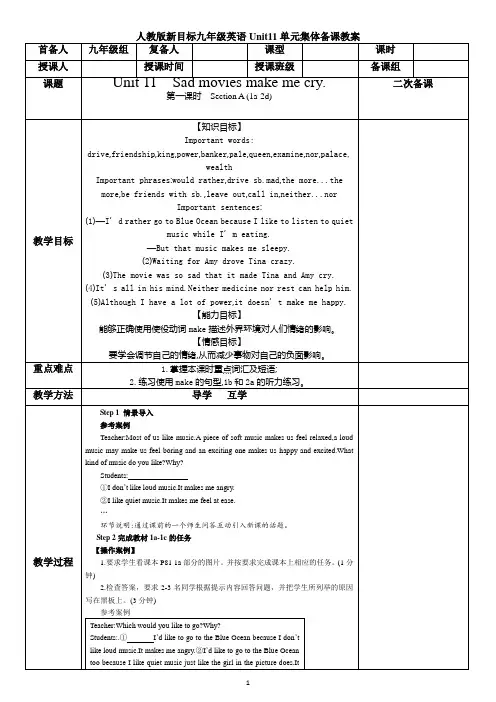
Once upon a time,there lived an unhappy king in a rich and beautiful country.He slept badly and didn t feel like eating.The queen and the people were very worried.They sent the most famous doctor to examine him.The doctor said nothing could help the king except a happy man s shirt.The prime minister,the banker and the palace singer were called in to the palace at once,but none of them said they were happy and each of them has their own worries.Finally,the king s top general was sent to find the happy man in three days time.Step 1完成教材3a-3b的任务【操作案例】1.根据课本P87 3a所给的提示,想一些使你高兴或悲伤的经历,和同伴进行讨论。
(2分钟)2.根据3a 写的提要以及3b所给的提示,写一篇与2b内容相似的短文。
(5分钟)学生完成后评出优秀的作文在班上展示。
(2分钟)环节说明:将读、写的任务结合起来不仅锻炼了学生的写作及对语言的综合运用能力,还巩固了学生对目标语言的学习、综合运用。
Step 2完成教材Self Check任务【操作案例】1.把表格中的单词放入表格中恰当的位置。
给出3分钟的时限,并请1位同学核对答案。
完成“1”部分的任务。
(3分钟)The answers:Positive:comfortable,relaxed,happyNegative:nervous,unhappy,uncomfortable,worried,angry,awful,uneasy2.参照例句,用所给的单词造句。
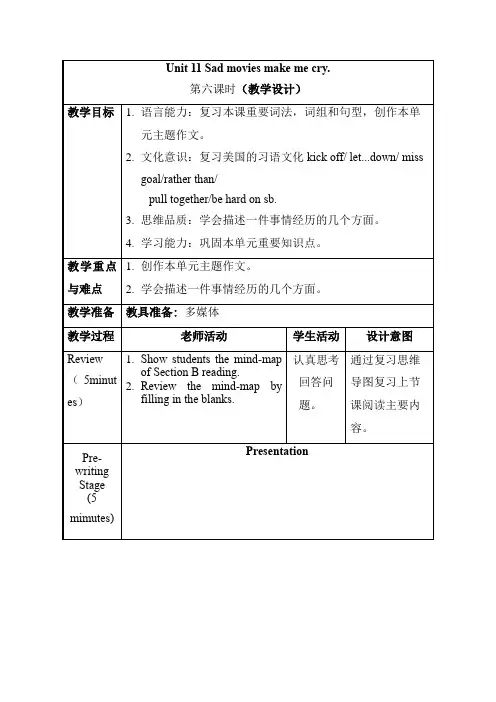

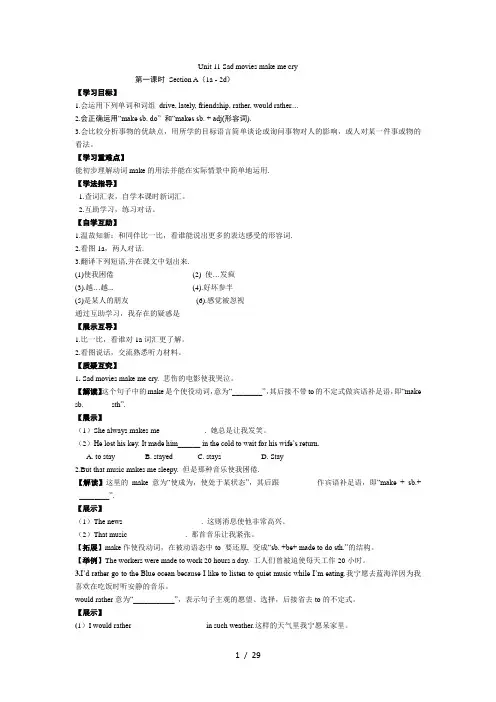
Unit 11 Sad movies make me cry第一课时Section A(1a - 2d)【学习目标】1.会运用下列单词和词组drive, lately, friendship, rather, would rather....2.会正确运用“make sb. do” 和“makes sb. + adj(形容词).3.会比较分析事物的优缺点,用所学的目标语言简单谈论或询问事物对人的影响,或人对某一件事或物的看法。
【学习重难点】能初步理解动词make的用法并能在实际情景中简单地运用.【学法指导】1.查词汇表,自学本课时新词汇。
2.互助学习,练习对话。
【自学互助】1.温故知新:和同伴比一比,看谁能说出更多的表达感受的形容词.2.看图1a,两人对话.3.翻译下列短语,并在课文中划出来.(1)使我困倦__________________ (2) 使…发疯_________________(3).越…越...___________________ (4).好坏参半____________________(5)是某人的朋友________________ (6).感觉被忽视__________________通过互助学习,我存在的疑惑是_________________________________________【展示互导】1.比一比,看谁对1a词汇更了解。
2.看图说话,交流熟悉听力材料。
【质疑互究】1. Sad movies make me cry. 悲伤的电影使我哭泣。
【解读】这个句子中的make是个使役动词,意为“________”,其后接不带to的不定式做宾语补足语,即“make sb. _______sth”.【展示】(1)She always makes me____________. 她总是让我发笑。
(2)He lost his key. It made him______ in the cold to wait for his wife’s return.A. to stayB. stayedC. staysD. Stay2.But that music makes me sleepy. 但是那种音乐使我困倦.【解读】这里的make 意为“使成为,使处于某状态”,其后跟__________作宾语补足语,即“make + sb.+ ________”.【展示】(1)The news_____________________. 这则消息使他非常高兴。
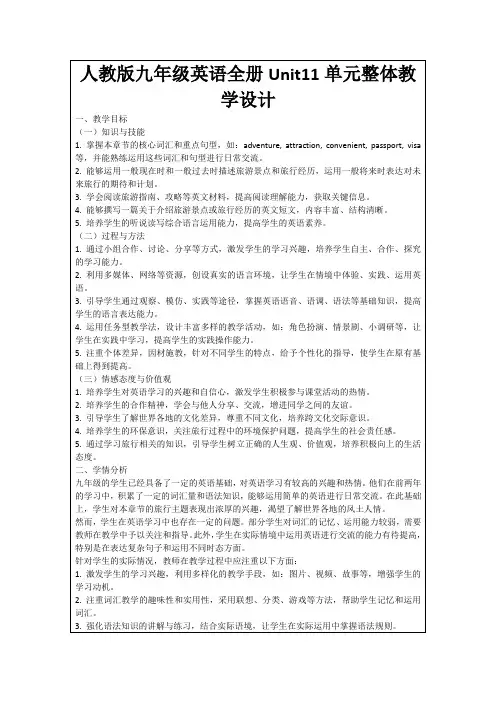
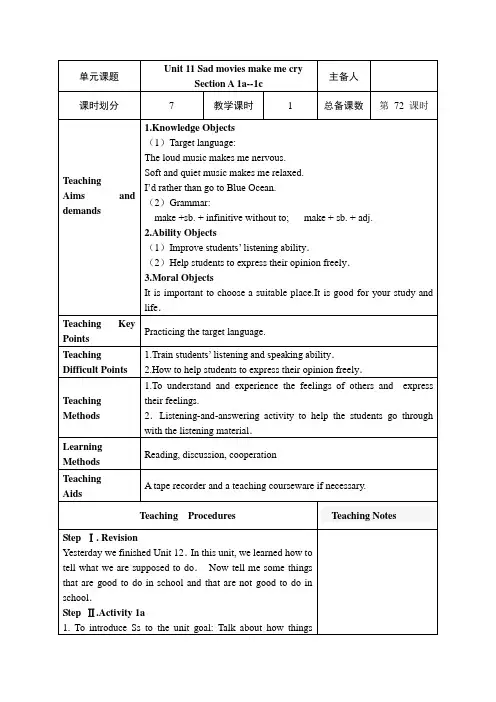

《英语》(新目标)九年级Unit 11英语课堂教学设计Unit 11 Could you please tell me where the restrooms are?一、教学内容:新目标(go for it!)九年级Unit 11 Could you please tell mewhere the restrooms are? Section A 1a-2c (Period one)二、指导思想:以学生为主体,激发和培养学生学习英语的兴趣,帮助他们建立学习的成就感和自信心,使他们在学习过程中发展综合语言运用能力,培养合作精神。
三、教学目标:●知识目标1.词汇:restroom shampoo drugstore department store2.语法:能够熟练运用宾语从句3.功能:在日常生活中能用Could you please tell me where/how…?有礼貌向他人询问信息,能描述地理位置、给他人指路或提供帮助4.话题:熟悉与日常生活有关的问路及指路的话题●能力目标1.听:能听懂有关熟悉话题(问路及指路)的谈话,并从中提取信息。
2.说:能用目标语有效地询问信息和请求帮助。
能根据话题进行情景对话。
3.读:能大声朗读对话。
4.写:能根据图示写出简单的段落或说明地理位置(课前任务时完成)●情感目标1.培养学生认识到学习英语的目的在于交流,乐于参与英语实践活动;2.在学习活动中积极与他人合作,相互帮助,共同完成学习任务。
●策略目标1.通过让学生根据实际需要进行课前预习,让学生形成有效的认知策略2.在课堂中创造机会,让学生用目标语进行交际,培养学生将知识转化为技能的有效的交际策略。
●文化意识知道如何礼貌与他人交换信息四、教学重点、难点●教学重点:宾语从句●教学难点:能结合重点句,根据问路、指路这一话题进行情景对话●教学策略1.采取任务型教学的设计理念,以“以询问信息和提供帮助”为主线,以任务为驱动,尝试采取“自主学习、合作学习”的教学模式,使学生在不同层次任务的驱动下主动、积极地参与教学。
Once upon a time,there lived an unhappy king in a rich and beautiful country.He slept badly and didn t feel like eating.The queen and the people were very worried.They sent the most famous doctor to examine him.The doctor said nothing could help the king except a happy man s shirt.The prime minister,the banker and the palace singer were called in to the palace at once,but none of them said they were happy and each of them has their own worries.Finally,the king s top general was sent to find the happy man in three days time.
Step 1完成教材3a-3b的任务
【操作案例】
1.根据课本P87 3a所给的提示,想一些使你高兴或悲伤的经历,和同伴进行讨论。
(2分钟)
2.根据3a 写的提要以及3b所给的提示,写一篇与2b内容相似的短文。
(5分钟)
学生完成后评出优秀的作文在班上展示。
(2分钟)
环节说明:将读、写的任务结合起来不仅锻炼了学生的写作及对语言的综合运用能力,还巩固了学生对目标语言的学习、综合运用。
Step 2完成教材Self Check任务
【操作案例】
1.把表格中的单词放入表格中恰当的位置。
给出3分钟的时限,并请1位同学核对答案。
完成“1”部分的任务。
(3分钟)
The answers:
Positive:comfortable,relaxed,happy
Negative:nervous,unhappy,uncomfortable,worried,angry,awful,uneasy
2.参照例句,用所给的单词造句。
完成“2”部分的任务。
(5分钟)
The answers:
2.Speaking in front of many people makes me nervous.
3.Money and fame don t always make people happy.
4.Soft piano music makes me relaxed.
5.Rainy days makes us stay at home and watch TV.
3.阅读方框中所给的单词,按照所代表的含义用1-6(1表示最不重要,6表示最重要)分别标出,表达它们对你的重要性,并根据你的选择,参照例句写六个句子。
完成“3”部分的任务。
(5分钟)
环节说明:本节主要是针对本单元的主要目标语言进行加强巩固训练,巩固了学生对目标语言的学习、识记和运用。